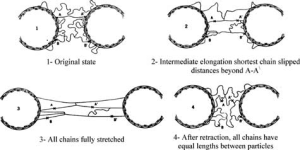Molecular slippage is a phenomenon that occurs when a molecule moves through a narrow channel or pore. It was first described by Dr. Ross E. Dannenberg, a researcher at the National Institutes of Health (NIH), in the early 1980s.
According to Dannenberg, when a molecule moves through a narrow channel or pore, it can sometimes experience a sudden “slip” or acceleration, allowing it to move through the channel more quickly than expected. This occurs because the molecule is able to temporarily reduce its size or “compress” itself, allowing it to pass through the channel more easily.
Dannenberg’s work on molecular slippage has been applied to a variety of fields, including biophysics, nanotechnology, and drug delivery. For example, researchers have used the concept of molecular slippage to design more efficient drug delivery systems, by creating channels or pores that allow drugs to move through more easily.
Overall, molecular slippage is an important phenomenon that helps us to better understand the behavior of molecules in confined spaces, and has important implications for a wide range of scientific fields.

 (909) 987-1774
(909) 987-1774 Email Us
Email Us







